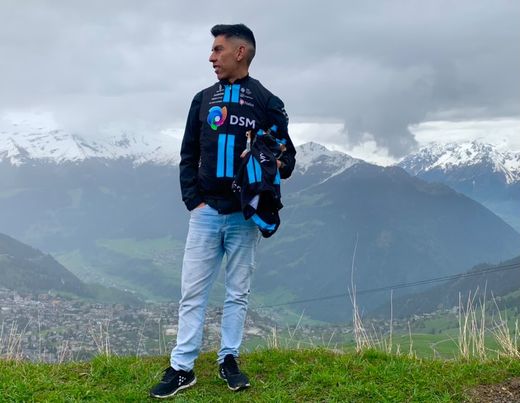Chef with an atypical background, Camilo Suarez plays an essential role in his team, especially on races. The Colombian who evolves with the Dutch of the DSM for the second season exposes us this rather unknown aspect of cycling. What are the real challenges of this profession in professional cycling? ?
In this exclusive interview, Camilo Suárez sheds light on his work with the DSM team and takes us behind the scenes of food preparation in the world of cycling.
Cycling Times : Can you tell us about your professional background ? How did you become a chef for the DSM team ?
Camilo Suarez : I was a professional cyclist in Colombia for 8 years. I had a lot of problems with my diet, I could not find my ideal weight for the competition. I retired from cycling in 2014 and I started to study gastronomy in Colombia. As a diploma project, I presented “The leader of the cyclist” and thanks to the contacts I had when I was a cyclist, I started cooking for European teams.
CT : Tell us about your role as a chef at DSM. What are your main responsibilities within the team? ?
CS : I am responsible for preparing meals for the runners before and after each training or competition, with all that entails : make the shopping list, purchases, washing dishes and cooking tasty and nutritious dishes.
CT : What challenges do you face when preparing meals for a professional cycling team like DSM ? How do you take into account the different dietary needs and preferences of the riders on the team ?
CS : The main challenge is having to move from place to place every day, moving a kitchen every day becomes a big challenge. I work hand in hand with a multidisciplinary team of nutritionists who give me specific menus and quantities for each runner..
CT : More and more top athletes choose not to consume animal products. Is this a phenomenon that you often encounter in the world of cycling ? If yes, is it a problem ?
CS : Yes, it's getting very popular. I try to follow a vegetarian diet, so when i have to cook vegetarian for a runner, it makes me very happy.
CT : Can you give us an example of a typical meal that you prepare for DSM runners during a race or intensive training ?
CS : fresh bread, with rolled oats soaked for 8 hours in lactose-free milk. For the lunch, it can be a sandwich or pasta with vegetables and a very light sauce, as well as a light cake with fresh ingredients. And for dinner, a starter like a vegetable soup, an easily digestible carbohydrate, with chicken or fish in general and other vegetables as a garnish, then a dessert similar to that of lunch.
CT : What role does nutrition play in the overall performance of DSM runners ? How do you work to optimize their diet and improve their performance ?
CS : Its very important. A team is in charge of developing the menus and ensuring the caloric load of each runner.
CT : What are the main trends or developments that you observe in the field of sports nutrition and how do you integrate them into your work at the DSM ?
The muscle scan, to know the amount of glycogen in the muscles of each cyclist. This information is transmitted to the nutritionists who then transmit it to me, translated into food weight.

CT : Can you tell us about an experience or a highlight in your work with the DSM team as a chef? ?
CS : My dream was to wear the pink jersey at some point in my life as a cyclist, but it never came true. However, This year, I cooked for the pink jersey during the Tour of Italy.
CT : How to reconcile the nutritional needs of runners with budgetary and logistical constraints ? Is this a challenge or a priority for the teams ?
CS : I usually send the race list to the hotels in advance and they provide the ingredients which are directly paid for by the race organizations themselves, and if something is missing, I complete with the money of the team, which is generally not very high.
CT : What advice would you give to amateur cyclists wishing to improve their diet to optimize their sports performance? ?
CS : I will advise them to eat slowly, eat real food (fruits, vegetables and cereals) and learn to cook yourself.
CT : On the last Giro, how did you experience the time trial of Monte de Lussari ? You were on the trail bike behind Jonas Hvideberg with his spare bike slung over your shoulder for long minutes. Was it planned for a long time ?
CS : It was a unique experience, the mountains with the snow were a postcard for the cyclists of this time trial. It was not planned, but the day before 23 hours, I was told that I had to accompany Jonas. As I was a former cyclist and now do yoga, I have skills with my body and it was not so difficult to carry the bike for so long.
Our warm thanks to Camilo for the contribution.
